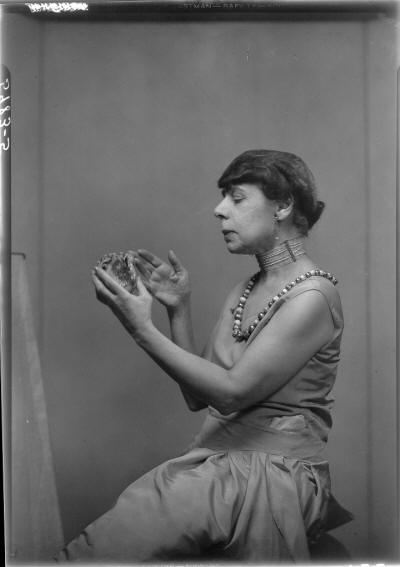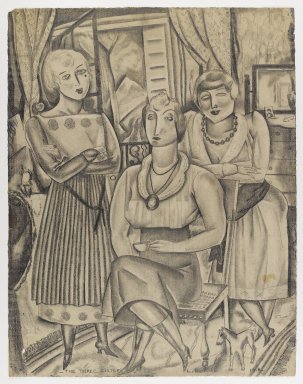Queer Places:
102 W 76th St, New York, NY 10023
Alwyn Court,
180 W 58th St, New York, NY 10019
 Carrie Stettheimer (July 23, 1869 – June 25, 1944) was one of three daughters born to a wealthy family in Rochester, New York. After spending much of her childhood in Europe, she and her family returned to New York City at the start of World War I. The Stettheimer family often hosted invite only parties at their rented Hudson River summerhouse. They would entertain guests from New York’s avant-garde, such as artists like
Francis Picabia,
Marcel Duchamp,
Georgia O’Keeffe,
Alfred Stieglitz,
Man Ray,
Charles Demuth,
Marsden Hartley, and writers and critics,
Henry McBride and
Carl Van Vechten. Carl Van Vechten,
Marcel Duchamp,
Leo Stein and
Gertrude Stein, Baron
Adolph de Meyer,
Avery Hopwood, Marquis de Buenavista, Rockwell Kent, among others. By 1916, the Stettheimer sisters had an established salon in New York. They became regular affairs in their Upper West Side brownstone on West 76th street, and later in midtown’s Alwyn Court on West 58th street. Their salons were semi-public events in a private residence where artists and intelligentsia from all social classes would gather.
Carrie Stettheimer (July 23, 1869 – June 25, 1944) was one of three daughters born to a wealthy family in Rochester, New York. After spending much of her childhood in Europe, she and her family returned to New York City at the start of World War I. The Stettheimer family often hosted invite only parties at their rented Hudson River summerhouse. They would entertain guests from New York’s avant-garde, such as artists like
Francis Picabia,
Marcel Duchamp,
Georgia O’Keeffe,
Alfred Stieglitz,
Man Ray,
Charles Demuth,
Marsden Hartley, and writers and critics,
Henry McBride and
Carl Van Vechten. Carl Van Vechten,
Marcel Duchamp,
Leo Stein and
Gertrude Stein, Baron
Adolph de Meyer,
Avery Hopwood, Marquis de Buenavista, Rockwell Kent, among others. By 1916, the Stettheimer sisters had an established salon in New York. They became regular affairs in their Upper West Side brownstone on West 76th street, and later in midtown’s Alwyn Court on West 58th street. Their salons were semi-public events in a private residence where artists and intelligentsia from all social classes would gather.
The daughters of wealthy German Jews, the Stettheimer sisters were raised in Rochester, New York. Their father deserted the family when they were children and, after two older siblings married and moved away, the three sisters, Carrie,
Ettie, and
Florine, and their mother Rosetta, became a close-knit family. Together with their mother, the Stettheimers lived and traveled in Europe for several years just after the turn of the century, often socializing with other expatriate Americans.
Each sister had their own role in the matriarchal salons. Carrie Stettheimer was the one that would stay home and care for their mother so she would organize and plan the event. She was the hostess, managing the extravagant dinner menus, including imaginative dishes like feather soup. She never dressed in trendy clothes, but rather elegant fashions of the past. Her greatest pleasures were reading, and conversation. All of the sisters examplified in their own way the idea of the “new woman” of the early 20th century.

by Arnold Genthe

by Carl Van Vechten

Florine Stettheimer, Portrait of My Sister, Carrie W. Stettheimer, 1923

Florine Stettheimer, Family Portrait I, 1915. Art Properties, Avery Architectural and Fine Arts Library, Columbia University in the City of New York, New York. Gift of the Estate of Ettie Stettheimer, 1967

Florine Stettheimer, Family Portrait II, 1933. Museum of Modern Art, New York. Gift of Miss Ettie Stettheimer, 1956. Image provided by The Museum of Modern Art / SCALA / Art Resource, New York

Louis (George Louis Robert) Bouché (American, 1896-1969). The Three Sisters, 1918. Graphite on cream, moderately thick, moderately textured laid paper, sheet: 24 3/16 x 18 7/8 in. (61.4 x 47.9 cm). Brooklyn Museum, Gift of Ettie Stettheimer, 45.121 (Photo: Brooklyn Museum, 45.121_IMLS_PS4.jpg)

Florine, Carrie, and Ettie Stettheimer
While Carrie Stettheimer largely managed the large household, she also undertook a perculiar art project which replicated the family home in miniature. She worked on the ambitious dollhouse for over twenty years. She even enlisted artist friends to create miniatures of their paintings and sculptures to decorate the two story, sixteen room house. Carrie Stettheimer spent twenty-five years on it, filling the house with reproductions of period furniture and replica light fixtures and lampshades. The model is on permanent display at the Museum of the City of New York (2018). It contains miniature art made for the dollhouse by artists like
Marcel Duchamp, Alexander Archipenko, George Bellows,
Gaston Lachaise, and
Marguerite Zorach.
After her mother's death in 1935, Carrie stopped working on the dollhouse and some rooms were left unfinished. Her sister Ettie (who survived both Florine and Carrie) donated the dollhouse to the Museum of the City of New York in 1945; she arranged the unfinished rooms (the Art Gallery or Ballroom and the Dining Room) as she thought her sister would have wanted them. The dollhouse is about 28 inches tall, 50 inches long, and 35 inches wide.[3]
Even in death the Stettheimers attracted artists; Pop artist Andy Warhol
wrote about the Stettheimers in his 1980 book Popism: the Warhol '60s.
"Florine Stettheimer was a wealthy primitive painter, a friend of Marcel
Duchamp’s, who’d had a one-woman show at the Museum of Modern Art in 1946, and
her sister Carrie had made some fabulous dollhouse that I loved at the Museum of the City of New York."[2]
My published books:


BACK TO HOME PAGE

 Carrie Stettheimer (July 23, 1869 – June 25, 1944) was one of three daughters born to a wealthy family in Rochester, New York. After spending much of her childhood in Europe, she and her family returned to New York City at the start of World War I. The Stettheimer family often hosted invite only parties at their rented Hudson River summerhouse. They would entertain guests from New York’s avant-garde, such as artists like
Francis Picabia,
Marcel Duchamp,
Georgia O’Keeffe,
Alfred Stieglitz,
Man Ray,
Charles Demuth,
Marsden Hartley, and writers and critics,
Henry McBride and
Carl Van Vechten. Carl Van Vechten,
Marcel Duchamp,
Leo Stein and
Gertrude Stein, Baron
Adolph de Meyer,
Avery Hopwood, Marquis de Buenavista, Rockwell Kent, among others. By 1916, the Stettheimer sisters had an established salon in New York. They became regular affairs in their Upper West Side brownstone on West 76th street, and later in midtown’s Alwyn Court on West 58th street. Their salons were semi-public events in a private residence where artists and intelligentsia from all social classes would gather.
Carrie Stettheimer (July 23, 1869 – June 25, 1944) was one of three daughters born to a wealthy family in Rochester, New York. After spending much of her childhood in Europe, she and her family returned to New York City at the start of World War I. The Stettheimer family often hosted invite only parties at their rented Hudson River summerhouse. They would entertain guests from New York’s avant-garde, such as artists like
Francis Picabia,
Marcel Duchamp,
Georgia O’Keeffe,
Alfred Stieglitz,
Man Ray,
Charles Demuth,
Marsden Hartley, and writers and critics,
Henry McBride and
Carl Van Vechten. Carl Van Vechten,
Marcel Duchamp,
Leo Stein and
Gertrude Stein, Baron
Adolph de Meyer,
Avery Hopwood, Marquis de Buenavista, Rockwell Kent, among others. By 1916, the Stettheimer sisters had an established salon in New York. They became regular affairs in their Upper West Side brownstone on West 76th street, and later in midtown’s Alwyn Court on West 58th street. Their salons were semi-public events in a private residence where artists and intelligentsia from all social classes would gather.






